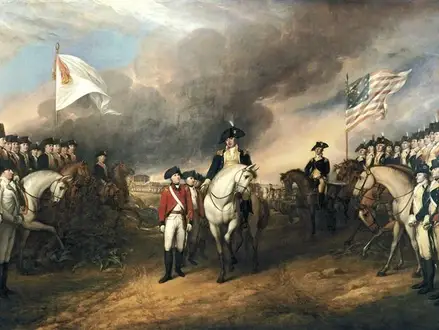Title of Artwork: “The Surrender of Lord Cornwallis”

Artwork by John Trumbull
Year Created 1819-1820
Summary of The Surrender of Lord Cornwallis
A John Trumbull oil painting depicts Lord Cornwallis’s surrender. As a result of its completion in 1820, this picture now resides in Washington, D.C.’s Rotunda of the United States Capitol Building.
On October 19, 1781, British Major General Charles, Earl Cornwallis surrendered at Yorktown, Virginia, bringing an end to the Siege of Yorktown and all but assuring the independence of the American colonies. This portrayal features several of the American soldiers that took part in the siege.
All About The Surrender of Lord Cornwallis
Early on in the American Revolutionary War, the artist enlisted and served as an adviser to both George Washington and Horatio Gates in the Continental Army. He became an artist after leaving the army in 1777. Sketches for large-scale paintings depicting the events of the American Revolution were first drawn up in 1785.
While in England in 1789, he returned to New York and sketched several dignitaries for inclusion in these works, including the likes of Benjamin Franklin and John Adams. When he went to Yorktown, Virginia to sketch the surrender location, he did so in 1791.
Upon his return to the United States from Britain at the end of the War of 1812, he advocated for this proposal in Congress. His application and successful showing in 1816, as well as drawings for other paintings, led Congress to commission four big works from him in 1817 to be hung at Capitol Rotunda in Washington, D.C.
For each painting, the price was fixed at $8,000, and the size and subject matter were to be decided by President Madison. The four paintings would be twelve feet by eighteen feet (370 centimetres by 550 centimetres), with the Declaration of Independence, the Surrender of General Burgoyne, the Surrender of Lord Cornwallis, and Washington Resigning His Commission as the four themes that were decided upon.
For the next eight years, Trumbull worked tirelessly to complete the assignment, which he did in 1820. Prior to its arrival to Washington D.C. in late 1820, it had been exhibited in New York City, Boston and Baltimore. Trumbull was in charge of its hanging and supervised its installation.
Since then, it’s been there. For the first time since 1828, the artwork has been cleaned and varnished by the artist himself. In 1971, the canvas was mended after being pierced by a penny hurled too forcefully. In 2008, the paintings in the Rotunda received their most thorough cleaning to date.
When the British army surrendered at Yorktown, Virginia, in September 1781, this painting depicted their final major battle of the Revolutionary War. The azure sky with black clouds and the damaged cannon hint at the warfare that preceded this catastrophe. ‘
When Cornwallis was encamped with 7,000 men at the beginning of September, he expected help from the sea, but a French navy rejected the British ships. When General Washington’s army was ready to attack the British lines in early October, he sent in a significantly bigger force than had previously been available. On October 19, after American and French forces had taken two British strongholds, Cornwallis gave up.
American General Benjamin Lincoln, on a white horse, stands in the middle of the picture. His right hand reaches out and grasps the surrendering British officer’s sword, which is held aloft by a lengthy line of soldiers in the backdrop. French officers stand and ride behind the white banner of the Bourbon royal family on the left.
The Marquis de Lafayette and Colonel Jonathan Trumbull, the painter’s brother, are depicted on the right, beneath the Stars and Stripes. While General George Washington rode a brown horse, Lord Cornwallis was absent from the surrender ceremony.
Information Citations
En.wikipedia.org, https://en.wikipedia.org/.





















